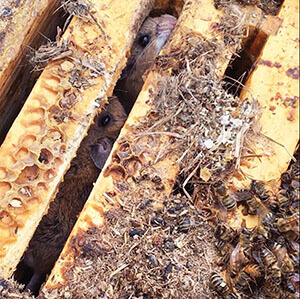
Honey bee colonies die. At some point you will stand over the sad sight of a dead colony, and will have to make decisions about what to do with the equipment. Do you dump a new package of bees straight into the hive and move on with life? Do you burn everything in a fit of rage and quit beekeeping? The right answer is likely somewhere in between, where we take some action to make the hive better for the next inhabitants, but we don’t overdo it and set ourselves back. How do we know how much work we should do? When we deal with deadouts, we need to find a balance: On one hand we want to save work and precious drawn comb, while on the other hand we want to reduce risk to the bees.
The boxes, lids, and bottom boards from a winter deadout can usually be safely reused with not too much effort. Scrape off dead bees, and take time to repair and repaint what needs it. Most of your focus should be on the comb, because that is where most of the risk lies. There are three reasons why you would want to get rid of old comb: It can hold pathogens, it can hold pesticides, and it can be structurally unusable.
Pathogen risk — Old comb can contain many pathogens. Colonies with old comb are more likely to have chalkbrood (Koenig et al., 1986), nosema disease (Bailey and Ball, 1991) and American foulbrood (Gilliam, 1985). It even seems like the varroa mite prefers old combs; one study showed that old combs were four to five times more infested with varroa than new combs (Piccirillo and DeJong, 2004). We know that some pathogens like Nosema and P. larvae (the bacterium responsible for American foulbrood) can last for years in wax, but we know much less about the viruses that are responsible for so many bee deaths these days. We do know that it is possible for viruses to end up in wax (Coldwell et al., 2017, deGuzman, 2019), but we don’t know much about how long they last, or if viruses in wax remain infectious to honey bees.
Switching out old comb does seem to help with pathogen loads. One study on virus risk showed that there was a higher presence of Acute Bee Paralysis Virus in colonies where comb replacement was not common practice (Molineri et al., 2017). Colonies that had comb switched for foundation in either the spring or fall had less nosema the following spring than colonies raised on old combs (Fries, 1988). Likewise, colonies infected with AFB that are shaken onto new comb have much lower infections than those left on old comb (Pernal et al., 2008).
Pesticide risk — Because wax is made of hydrocarbons, it acts like a sponge, holding onto many chemicals. Studies have shown that most hives contain pesticides in the wax and stored pollen (Mullin 2010). Because in-hive pesticide exposures are so complex (each hive has its own signature blend of chemicals), the effects of these stored chemicals are really difficult to study. However, there are studies that show that Nosema ceranae infections were higher in adult bees, and occurred earlier in young bees reared in combs with high pesticides (Wu et al., 2012). Even in the absence of nosema, bees reared on high-pesticide combs had delayed development and died earlier (Wu et al., 2011), and there is a relationship between a high number of chemicals in the hive and the risk of mortality and negative queen events (Traynor et al., 2016).
Structure — New brood comb is pure wax, but old brood comb is a combination of wax and silk and propolis, and has different properties. Just before pupation, honey bee larvae cover the walls of their cells with silk. Each following generation will apply more silk to the walls, and the cells become smaller and smaller and the ratio of silk to wax greater. In nature, bees move the brood nest within the cavity, and generally will raise brood on newer comb, using old comb for food storage. When we restrict the broodnest, bees are forced to reuse the same comb over and over. A study at the University of Georgia showed that brood nests made of new comb had more brood (larger area), and that the bees that emerged from cells in new comb were of higher weight (Berry and Delaplane, 2001). A recent study from the Middle East found that colonies with newer comb (1-3 years old) had higher numbers of overall foragers, more foragers with pollen loads, a higher rate of storing pollen, more worker brood, and greater colony size than colonies on older comb (Taha and Kahtani, 2020).
While we do know that there are advantages to raising bees on new comb, there is also a ….


